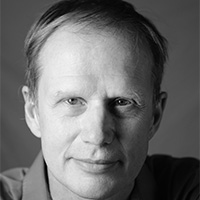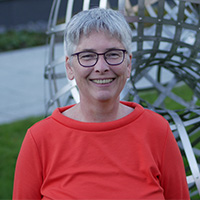By Arnd Scheel and Angela Stevens
Most living organisms can regenerate tissue or parts of organs, but to significantly different degrees. Deer can regrow their antlers, fish their fins, geckos their tails, and some crabs and salamanders complete limbs. However, tissue regeneration is very limited in humans. Because a better understanding of regeneration clearly holds tremendous potential for medical therapies, researchers have directed extensive efforts towards an organism with an amazing capability for recovery after dramatic injury: the planarian.
Figure 1. Planarians (here the species
Dugesia subtentaculata) are nonparasitic flatworms that live in freshwater streams and ponds. Image courtesy of Eduard Solà under
Creative Commons BY-SA 3.0.
Planarians are nonparasitic flatworms that live in freshwater streams and ponds (see Figure 1). For the species
Schmidtea mediterranea, each organism is between one and 20 millimeters long and consists of 100,000 to more than 2,000,000 cells. Small tissue parts that are cut from a flatworm—in extreme cases, just 0.5 percent of the organism—can regrow to a fully intact and functioning planarian. The new head grows on the side of the fragment that was closest to the head in the original flatworm [2]. A different experiment grafts tissue parts from a donor planarian into a host. The new flatworm usually recovers, absorbing the new tissue with novel positional information. But in some cases, it preserves the old positional information and grows a second head, for instance [3]. Figure 2 and Animations 1 and 2 show schematics of cutting and grafting.
Small tissue fragments display minimal residual spatial structure. One can therefore examine regeneration in the context of pattern formation and self-organization, making comparisons with Alan Turing’s activator-inhibitor systems [5] or Lewis Wolpert’s French flag model [6]. However, the inherent selection of spatial scales in activator-inhibitor systems poorly matches the robustness of regeneration across orders of magnitude in body length. In the French flag model, a global signal gradient across the organism can inform and guide stem cell differentiation and organ development through its local concentrations. Yet regeneration in planarians appears to be largely independent of the location of tissue fragments in the donor, leaving us to ponder the following question: How is a global signaling gradient reestablished in a fragment in a way that robustly preserves orientation?
Figure 2. Schematics of planarian regeneration in experiment and model. Reprinted with permission from Springer Nature: Journal of Mathematical Biology (2021). Full citation available in [4].
We developed and analyzed a mathematical model that provides partial answers. It identifies essential ingredients of regeneration and reproduces—among other phenomena—both cutting and grafting experiments [4]. As with the French flag model, our model is based on global signals. But it requires sensing of gradients rather than absolute concentrations of signals and predicts regeneration and its limitations from a Turing-type instability analysis, which is boundary-driven. We use a reaction-diffusion system to describe the evolution of densities of cell types and signals along the head to tail axis \(x \in [-L,L]\) of the flatworm. Stem cells \(s\) proliferate, undergo apoptosis [1], and differentiate irreversibly into head and tail cells \((\color{blue}{h},\color{red}{d})\) — guided by positional control genes that we relate to localized signals \(\color{CornflowerBlue}{u_h}\) and \(\color{tan}{u_d}\). Head and tail cells control those signals; they do not proliferate but do undergo apoptosis. All of these processes occur during both normal tissue turnover and regeneration [2].
Animation 1. Homeostasis and regeneration after cutting in planarians. Courtesy of Arnd Scheel, Angela Stevens, and Christoph Tenbrock.
The key to regeneration is a long-range signal \(\color{green}{w}\) (in short, Wnt signal) that is produced by tail cells and degraded by head cells, thus establishing a long-range gradient. The underlying Wnt/\(\beta\)-catenin signaling pathway has been conserved across species during evolution. It plays a crucial role in cell-to-cell communication and is important for stem cell renewal, cell proliferation, and cell differentiation, both during embryonic development and for adult tissue homeostasis and self-renewal.
\[\partial_t s=D_s\partial_{xx}s+p_s {s}{(1+s)^{-1}} - \eta_s s-p_h\color{CornflowerBlue}{u_h}s-p_d\color{tan}{u_d}s, \\ \partial_t \color{blue}{h}=D_h\partial_{xx}\color{blue}{h}+p_h\color{CornflowerBlue}{u_h}s-\eta_h\color{blue}{h}, \\ \partial_t \color{red}{d}=D_d\partial_{xx}\color{red}{d}+p_d\color{tan}{u_d}s-\eta_d\color{red}{d}, \\ \partial_t \color{CornflowerBlue}{u_h} = D_{{u_h}{}} \partial_{xx}\color{CornflowerBlue}{u_h} + \color{blue}{h}^2 (r_0 - r_1 \color{CornflowerBlue}{u_h}) - r_2 \color{CornflowerBlue}{u_h} \color{red}{d} - r_3 \color{CornflowerBlue}{u_h}, \\ \partial_t \color{tan}{u_d} = D_{{u_d}} \partial_{xx}\color{tan}{u_d} +\color{red}{d}^2 (r_0 - r_1 \color{tan}{u_d}) - r_2 \color{tan}{u_d} \color{blue}{h} - r_3 \color{tan}{u_d} \\ \partial_t \color{Green}{w} = D_w \partial_{xx}\color{Green}{w} - p_w \color{blue}{h} \color{Green}{w} + p_w \color{red}{d} (1-\color{Green}{w}) .\]
The role of the global signal in our model differs from the French flag model in that it guides a boundary-specific stem cell differentiation mechanism through the sign of the gradient of the Wnt signal relative to the body edge, therefore enabling the detection of orientation and preservation of polarity in regeneration. Modeling such a mechanism requires dynamic (Wentzell) boundary conditions, which preserve the signal’s gradient while concentrations adapt. Technically, one assumes that Dirichlet boundary values—for instance, values \(\color{blue}{h}_\pm\) for head cell concentrations \(\color{blue}{h}\) at \(x= \pm L\)—evolve as in the bulk, modeling a body edge compartment of mass \(\gamma\) along with an added fast proliferation that is triggered by positive outer normal derivatives of the Wnt signal via a smoothed Heaviside function \(H\). The sharp spike in stem cell differentiation at the boundary that is induced by this mechanism is supported by experimentally observed stem cell proliferation near wound edges and the presence of global gradients of chemical signals, which are related to the Wnt signaling pathway.
\[\frac{\textrm{d}}{\textrm{d} t}\color{blue}{h}_\pm=-\frac{1}{\gamma}D_h \left.\partial_\nu \color{Blue}{h}\right|_{x=\pm L}+p_h\color{CornflowerBlue}{u_h}s-\eta_h\color{Blue}{h}+ \tau(1-\color{blue}{h})(1-\color{red}{d}) H(\partial_\nu \color{Green}{w}). \]
Animation 2. Grafting experiments in planarians: persistence of donor head versus merging with host head. Courtesy of Arnd Scheel, Angela Stevens, and Christoph Tenbrock.
Our system robustly reproduces regeneration in most cutting and grafting experiments and preserves polarity after cutting. It crucially yields consistent results over organism scales that differ by factors of 100, which are compatible with strong shrinkage under the starvation and regrowth of flatworms. The regulation of stem cell differentiation through local signals \((\color{CornflowerBlue}{u_h}, \color{tan}{u_d})\) induces coexistence of stable head-only, tail-only, and—in our model—featureless trunk states. Grafting experiments are thereby well reproduced in our model when, for example, head grafts merge with existing head regions. They are also well reproduced with new outgrowth when head grafts coexist with trunk tissue.
One can glean a better understanding of regeneration from a heuristic reduction:
\[\frac{\textrm{d}}{\textrm{d} t}\color{Green}{w}=\partial_{xx} \color{Green}{w},\qquad \color{Green}{w}|_{x=\pm L}=\color{Green}{w}_\pm,\qquad \frac{\textrm{d}}{\textrm{d} t}\color{Green}{w}_\pm = \tau \left(H(\partial_\nu \color{Green}{w})-\color{Green}{w}_\pm\right), \]
Our system reduces to a scalar equation for the scaled Wnt signal with smoothed Heaviside function \(H\), so that boundary values \(w_{\pm}\) to \(1\) for positive outer normal derivatives and to \(0\) otherwise. Robust recovery is lost for decreased rates \(\tau\) of differentiation at the body edge. A linear stability analysis of the featureless equilibrium \(\color{Green}{w\equiv 1/2}\) detects this failure to regenerate as a loss of instability against small residual gradients in \(\color{Green}{w}\). In fact, the structure-forming instability first turns into an oscillatory instability before entirely disappearing as \(\tau\) decreases, thus predicting non-monotone behavior in chemical signals near failure of recovery (see Animation 3).
Animation 3. Regeneration versus failure of regeneration after cutting in planarians. Courtesy of Arnd Scheel, Angela Stevens, and Christoph Tenbrock.
Beyond this particular model, we suspect that effective gradient sensing of the Wnt signal is key to robust regeneration in planarians with the preservation of polarity. Sensing of signal levels alone, as in the French flag model, will not suffice. Our model also points to other possible disruptions of the global signaling gradient, which one can observe through specific experimental setups related to grafting or suppression of signaling, to sensing, or to cell proliferation. These collective insights may shed further light on the impressive regenerative abilities of this astounding organism.
Arnd Scheel presented this research during a minisymposium at the 2021 SIAM Conference on Applications of Dynamical Systems, which took place virtually in May 2021.
References
[1] Baguñà, J., Romero, R., Saló, E., Collet, J., Auladell, C., Ribas, M., …, Bueno, D. (1990). Growth, degrowth and regeneration as developmental phenomena in adult freshwater planarians. In Experimental embryology in aquatic plants and animals (pp. 129-162). New York, NY: Springer.
[2] Reddien, P.W., & Alvarado, A.S. (2004). Fundamentals of planarian regeneration. Annu. Rev. Cell Dev. Biol., 20, 725-757.
[3] Rink, J.C. (2018). Stem cells, patterning and regeneration in planarians: Self-organization at the organismal scale. In Planarian regeneration (pp. 57-172). New York, NY: Springer.
[4] Scheel, A., Stevens, A., & Tenbrock, C. (2021). Signaling gradients in surface dynamics as basis for planarian regeneration. J. Math. Biol., 83, 6.
[5] Turing, A.M. (1952). The chemical basis of morphogenesis. Phil. Trans. Roy. Soc. B, 237(641), 37-72.
[6] Wolpert, L. (1969). Positional information and the spatial pattern of cellular differentiation. J. Theor. Biol., 25(1), 1-47.

|
Arnd Scheel is a professor of mathematics at the University of Minnesota. His interests include nonlinear dynamics and partial differential equations, particularly when applied to pattern formation, nonlinear waves, and self-organization. |
 |
Angela Stevens is a professor of mathematics at the University of Münster. She is particularly interested in partial differential equations, stochastic many-particle systems, and mathematical modeling in the life sciences. |